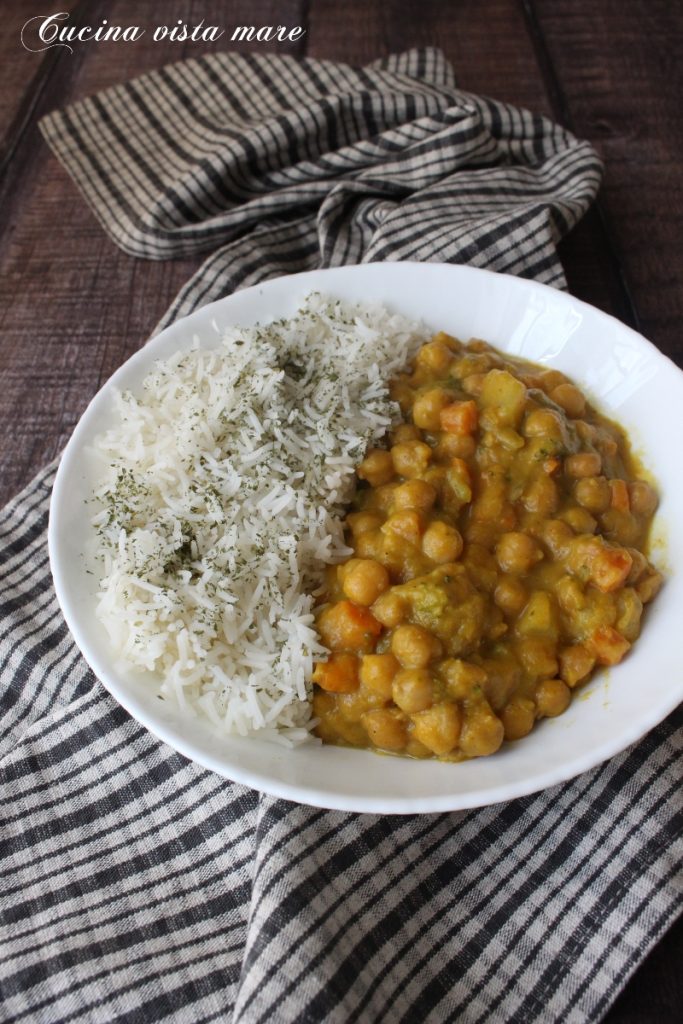The chickpea curry with vegetables is a complete, warm, and “comforting” dish, a rich, flavorful, spicy, creamy recipe. In one word, “delicious”. The chickpea curry with vegetables prepared this way is perfect if you have vegan friends over for dinner, it’s great for those on a gluten-free diet (but be careful of kitchen contamination), and it’s especially ideal when you find it ready to greet you upon your return home.
Do not miss

- Difficulty: Easy
- Cost: Economical
- Preparation time: 25 Minutes
- Portions: 2 people
- Cooking methods: Other, Stove
- Cuisine: Italian
- Seasonality: All seasons
Ingredients
- 9 oz cooked chickpeas (peeled)
- 1/2 delica pumpkin
- 2 carrots
- 1 potato
- some broccoli florets
- 1/2 golden onion
- 2 tbsps extra virgin olive oil
- 2 tsps curry
- 1/2 tsp cumin
- 1/2 tsp paprika
- 2 cups water
- to taste salt
- 7 oz canned coconut milk
- 6.3 oz Basmati rice
Tools
- 1 High-sided saucepan
- 1 Cutting board
- 1 Kitchen knife
- 1 Peeler
- 1 Rice cooker
- 1 Kenwood hand blender
Steps
In a high-sided saucepan, pour the oil and spices (curry, paprika, and cumin), add the chopped onion and peeled vegetables cut into small cubes. Finally, add the peeled chickpeas (it’s important to remove the skin that covers them). Let it flavor, adjust the salt, stir, and then add the water. Vegetable broth is also fine if you have it ready. I added a teaspoon of homemade vegetable broth paste that I keep in the freezer to the hot water. Cover with the lid and let cook until the vegetables are tender. The recipe says 15 minutes but it wasn’t enough for me so I let it cook for another 10 minutes. Once the vegetables are cooked, add the coconut milk: the thick part of the canned one. Check the packaging for usage instructions as some need to be refrigerated before use. Stir and let it thicken. The chickpea curry with vegetables is ready to be served with basmati rice.
For cooking basmati rice, I use the rice cooker: soak the basmati rice for thirty minutes then rinse it very well under running water (this step is essential for optimal cooking), transfer it to the rice cooker with water in a 1:1 ratio, so in this case 180 grams of rice with 180 grams of water. Season with salt. Start the rice cooker following the instructions in your manual as each machine is different. Cooking will be automatic. If you don’t have a rice cooker, you’ll need to proceed in a saucepan for absorption. I leave the instructions in the notes at the end of the article.
Notes
This content contains one or more affiliate links.
Basmati rice is rich in starch, so for compact and well-separated grains, it’s important to soak it for half an hour so the grains don’t break during cooking. Equally important is rinsing it very well under cold water for at least 3/4 times or until the water is clear because the rice will no longer have any starch residue.
For classic cooking (without a rice cooker), it’s best to proceed with a rice-to-water ratio of 1:2, so more than in the rice cooker. In the saucepan, bring the water to a boil, add the rice and a pinch of salt, cover and let cook on high heat for at least three minutes. Lower the heat and continue cooking, still covered, for 10 minutes. Then turn off the heat and let the rice cool inside the saucepan. Another method is to immediately pour the rice into the saucepan with water, a drizzle of oil, and a pinch of salt. Cover and bring to a boil over not too high heat. As soon as it boils, turn off the heat and let the rice rest covered inside the saucepan without ever opening the lid for a couple of hours. Fluff the rice with a fork and serve.
My advice? Buy a rice cooker if you have space to store it. You often find it on sale, and it will turn your situation around.
If you prefer a creamier result for your curry with vegetables, you can blend part of the mixture with an immersion blender before adding the coconut milk.
You can vary the vegetables as you like: here I used pumpkin, broccoli, potatoes, but spinach, zucchini, and cauliflower are also great.
If you don’t like chickpeas, you can use lentils or beans, or make a mix of legumes.
Spices are essential: you can decrease the quantities or use more, but they must be there.

